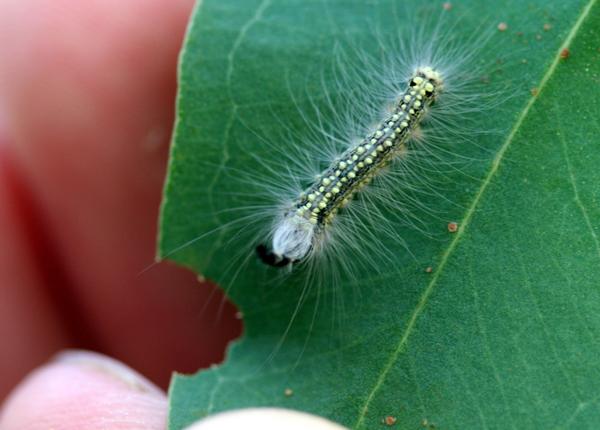Poisonous caterpillar reaches Kerikeri

The gum leaf skeletoniser - a pest caterpillar bristling with poisonous spines - has now been discovered in Kerikeri, prompting a warning for adults to keep an eye on curious children.
The pest - whose caterpillar stage has stiff, hollow spines that can deliver painful stings - was discovered several months ago in Whangarei, sparking warnings from Northland Regional Council biosecurity staff.
Don McKenzie, the council's Biosecurity Senior Programme Manager, says until that Whangarei discovery, the pest - which damages gum trees by eating their leaves -had only been recorded as far north as the Warkworth area.
"Since then our staff have been doing sporadic checks throughout Northland for gum leaf skeletoniser (GLS) including setting pheromone traps in a stand of Kerikeri eucalypts. Those traps have recently caught a number of adult moths and subsequent checks have also revealed caterpillars in the area."
It was likely the moths had been carried north on the wind or arrived under bark or in infected leaf litter.
Mr McKenzie urges adults in the Kerikeri area to keep an eye on their children, who might be attracted to the unusual-looking caterpillars, which are hairy and pale yellow with black and grey markings.
"The spines from GLS caterpillars are stiff and hollow and the venom in them can be injected into skin on contact even if the insect is dead, causing severe pain, itchy welts and a reaction that can last for days."
Ice packs applied to an exposed area and antihistamine creams can help those who are stung, however, if symptoms develop beyond the immediate sting area (like a widespread rash, shortness of breath or collapse) an ambulance should be called immediately.
If a Gum Leaf Skeletoniser caterpillar is eaten - especially by a child - medical attention needs to be sought immediately. If the insect comes into contact with an eye, the area needs to be washed thoroughly and again, medical help sought.
Mr McKenzie says the regional council recognised the insect as a potential risk to Northland some time ago and has been helping to fund the breeding of a host-specific parasitic wasp to target it.
A few weeks ago staff from the regional council and Scion Forest Protection released dozens of gum leaf skeletoniser GLS larvae infected with the eggs of a small parasitic wasp (Cotesia urabae) as a biological control agent in a Morningside, Whangarei gum plantation.
However, he says at this stage, the wasps have not built up in sufficient numbers to release any in Kerikeri - or anywhere else in Northland they may yet be discovered.
"Our advice at this stage is for people to be aware that these things are present as eggs, caterpillars and moths and are now likely to be permanently established in our region."
Mr McKenzie says although it favours eucalypts, Gum Leaf Skeletoniser also thrives on silver birch and can damage some oak, copper beech and plum.
The pest goes through four very different looking life stages.
Its eggs are about 1 mm in diameter and are laid in groups 100-200 in parallel rows on young leaves. The eggs are yellow-green at first, turning brown as they develop.
Caterpillars are hairy and pale yellow with black and grey markings. Older caterpillars have a distinctive 'hat' on their heads.
Its cocoons are usually formed under bark or in leaf litter and are rarely seen while moths are dull grey with silver-grey forewings and a wingspan of 20-30mm.
Mr McKenzie says two life cycles are completed annually, one in summer and one winter.
He says a booklet, factsheet and series of frequently asked questions about Gum Leaf Skeletoniser's health effects and management is available online at: http://www.biosecurity.govt.nz/pests/gum-leaf-skeletoniser
Further information is also available from Northland Regional Council offices.
